Nursing Assignment: Analysis of a Client with Drug Addiction
VerifiedAdded on 2023/06/03
|11
|2615
|467
AI Summary
This nursing assignment analyzes a client with drug addiction. The client's interview responses and observations are evaluated according to the MSE guidelines. Recommendations for treatment are provided.
Contribute Materials
Your contribution can guide someone’s learning journey. Share your
documents today.
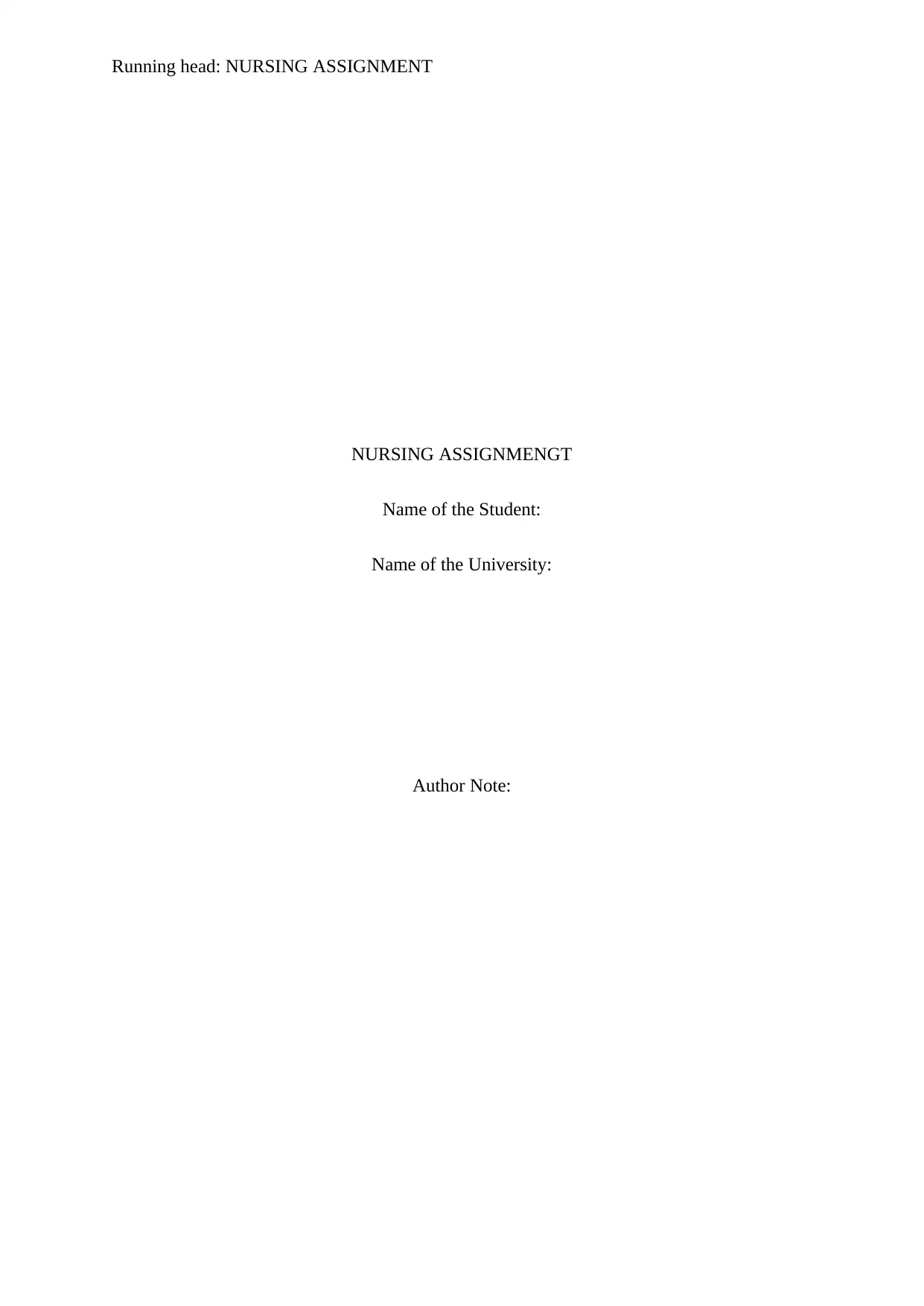
Running head: NURSING ASSIGNMENT
NURSING ASSIGNMENGT
Name of the Student:
Name of the University:
Author Note:
NURSING ASSIGNMENGT
Name of the Student:
Name of the University:
Author Note:
Secure Best Marks with AI Grader
Need help grading? Try our AI Grader for instant feedback on your assignments.
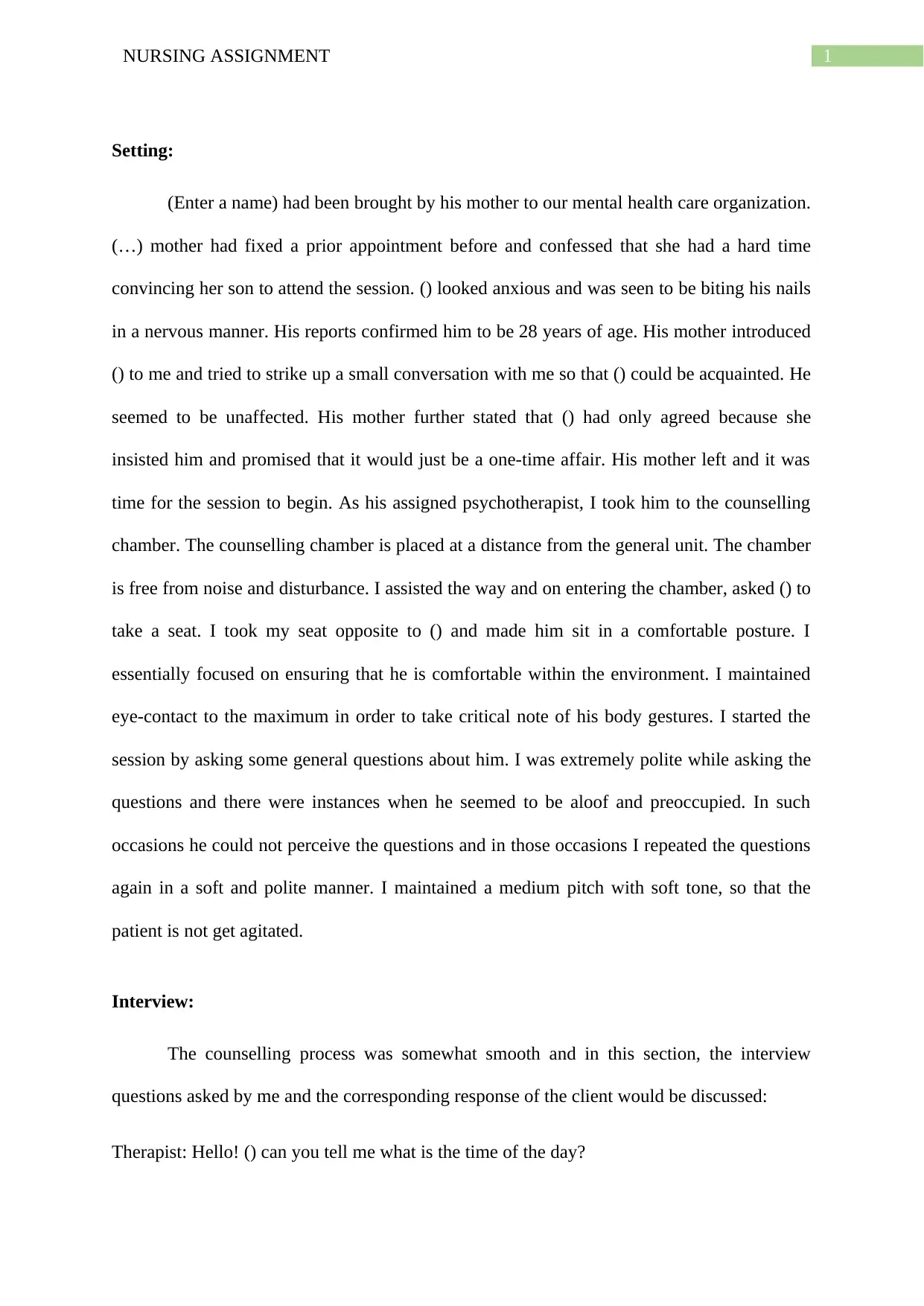
1NURSING ASSIGNMENT
Setting:
(Enter a name) had been brought by his mother to our mental health care organization.
(…) mother had fixed a prior appointment before and confessed that she had a hard time
convincing her son to attend the session. () looked anxious and was seen to be biting his nails
in a nervous manner. His reports confirmed him to be 28 years of age. His mother introduced
() to me and tried to strike up a small conversation with me so that () could be acquainted. He
seemed to be unaffected. His mother further stated that () had only agreed because she
insisted him and promised that it would just be a one-time affair. His mother left and it was
time for the session to begin. As his assigned psychotherapist, I took him to the counselling
chamber. The counselling chamber is placed at a distance from the general unit. The chamber
is free from noise and disturbance. I assisted the way and on entering the chamber, asked () to
take a seat. I took my seat opposite to () and made him sit in a comfortable posture. I
essentially focused on ensuring that he is comfortable within the environment. I maintained
eye-contact to the maximum in order to take critical note of his body gestures. I started the
session by asking some general questions about him. I was extremely polite while asking the
questions and there were instances when he seemed to be aloof and preoccupied. In such
occasions he could not perceive the questions and in those occasions I repeated the questions
again in a soft and polite manner. I maintained a medium pitch with soft tone, so that the
patient is not get agitated.
Interview:
The counselling process was somewhat smooth and in this section, the interview
questions asked by me and the corresponding response of the client would be discussed:
Therapist: Hello! () can you tell me what is the time of the day?
Setting:
(Enter a name) had been brought by his mother to our mental health care organization.
(…) mother had fixed a prior appointment before and confessed that she had a hard time
convincing her son to attend the session. () looked anxious and was seen to be biting his nails
in a nervous manner. His reports confirmed him to be 28 years of age. His mother introduced
() to me and tried to strike up a small conversation with me so that () could be acquainted. He
seemed to be unaffected. His mother further stated that () had only agreed because she
insisted him and promised that it would just be a one-time affair. His mother left and it was
time for the session to begin. As his assigned psychotherapist, I took him to the counselling
chamber. The counselling chamber is placed at a distance from the general unit. The chamber
is free from noise and disturbance. I assisted the way and on entering the chamber, asked () to
take a seat. I took my seat opposite to () and made him sit in a comfortable posture. I
essentially focused on ensuring that he is comfortable within the environment. I maintained
eye-contact to the maximum in order to take critical note of his body gestures. I started the
session by asking some general questions about him. I was extremely polite while asking the
questions and there were instances when he seemed to be aloof and preoccupied. In such
occasions he could not perceive the questions and in those occasions I repeated the questions
again in a soft and polite manner. I maintained a medium pitch with soft tone, so that the
patient is not get agitated.
Interview:
The counselling process was somewhat smooth and in this section, the interview
questions asked by me and the corresponding response of the client would be discussed:
Therapist: Hello! () can you tell me what is the time of the day?

2NURSING ASSIGNMENT
Client: (stares blankly and doesn’t respond)
Therapist: Hey Dear, can you please tell me what is the date and time of the week?
Client: (stares blankly and after a long pause) 10:00 AM, Thursday.
Therapist: can you tell me, why are you here?
Client: (In an unclear voice) hjkkhhjin
Therapist: could you please repeat that for me
Client: counselling
Therapist: What makes you uncomfortable?
Client: ‘people around me’
Therapist: can you tell me when was the first time you did drugs?
Client: Last year at a friend’s party.
Therapist: Who introduced you to drugs?
Client: It was a wild party. I saw everybody was enjoying and getting high. I wanted to feel
that way.
Therapist: Can you recall when was the day you did drugs?
Client: No, I don’t. When you get high you don’t remember anything.
Therapist: What was the first drug that you used?
Client: (After a long pause)… I have never used drugs… laughing hard.
Therapist: Calm down dear. I am here to help you.
Client: (Gradually gaining control)
Client: (stares blankly and doesn’t respond)
Therapist: Hey Dear, can you please tell me what is the date and time of the week?
Client: (stares blankly and after a long pause) 10:00 AM, Thursday.
Therapist: can you tell me, why are you here?
Client: (In an unclear voice) hjkkhhjin
Therapist: could you please repeat that for me
Client: counselling
Therapist: What makes you uncomfortable?
Client: ‘people around me’
Therapist: can you tell me when was the first time you did drugs?
Client: Last year at a friend’s party.
Therapist: Who introduced you to drugs?
Client: It was a wild party. I saw everybody was enjoying and getting high. I wanted to feel
that way.
Therapist: Can you recall when was the day you did drugs?
Client: No, I don’t. When you get high you don’t remember anything.
Therapist: What was the first drug that you used?
Client: (After a long pause)… I have never used drugs… laughing hard.
Therapist: Calm down dear. I am here to help you.
Client: (Gradually gaining control)
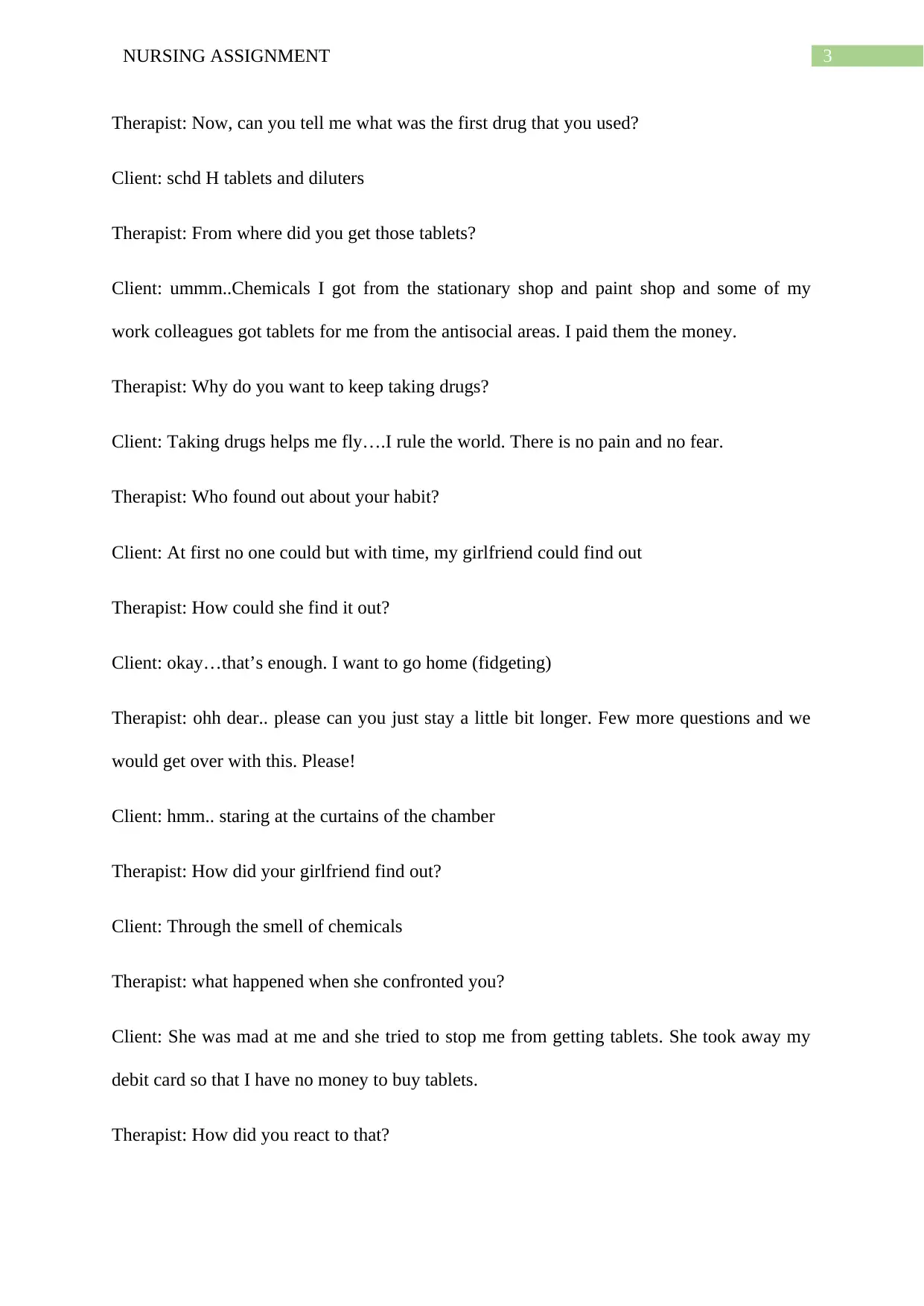
3NURSING ASSIGNMENT
Therapist: Now, can you tell me what was the first drug that you used?
Client: schd H tablets and diluters
Therapist: From where did you get those tablets?
Client: ummm..Chemicals I got from the stationary shop and paint shop and some of my
work colleagues got tablets for me from the antisocial areas. I paid them the money.
Therapist: Why do you want to keep taking drugs?
Client: Taking drugs helps me fly….I rule the world. There is no pain and no fear.
Therapist: Who found out about your habit?
Client: At first no one could but with time, my girlfriend could find out
Therapist: How could she find it out?
Client: okay…that’s enough. I want to go home (fidgeting)
Therapist: ohh dear.. please can you just stay a little bit longer. Few more questions and we
would get over with this. Please!
Client: hmm.. staring at the curtains of the chamber
Therapist: How did your girlfriend find out?
Client: Through the smell of chemicals
Therapist: what happened when she confronted you?
Client: She was mad at me and she tried to stop me from getting tablets. She took away my
debit card so that I have no money to buy tablets.
Therapist: How did you react to that?
Therapist: Now, can you tell me what was the first drug that you used?
Client: schd H tablets and diluters
Therapist: From where did you get those tablets?
Client: ummm..Chemicals I got from the stationary shop and paint shop and some of my
work colleagues got tablets for me from the antisocial areas. I paid them the money.
Therapist: Why do you want to keep taking drugs?
Client: Taking drugs helps me fly….I rule the world. There is no pain and no fear.
Therapist: Who found out about your habit?
Client: At first no one could but with time, my girlfriend could find out
Therapist: How could she find it out?
Client: okay…that’s enough. I want to go home (fidgeting)
Therapist: ohh dear.. please can you just stay a little bit longer. Few more questions and we
would get over with this. Please!
Client: hmm.. staring at the curtains of the chamber
Therapist: How did your girlfriend find out?
Client: Through the smell of chemicals
Therapist: what happened when she confronted you?
Client: She was mad at me and she tried to stop me from getting tablets. She took away my
debit card so that I have no money to buy tablets.
Therapist: How did you react to that?
Secure Best Marks with AI Grader
Need help grading? Try our AI Grader for instant feedback on your assignments.

4NURSING ASSIGNMENT
Client: I felt like stabbing her to death. I could not stand her. She tried to control me.
Therapist: And what did you do then?
Client: We had arguments and then one day she just waked away and left me
Therapist: What was the reaction of your family?
Client: Before leaving, she told my mom.
Therapist: what was her reaction?
Client: At first she broke down completely and was scared to even talk to me.
Therapist: How did your girlfriend and your mother’s reaction make you feel?
Client: They just don’t know how ‘the trip’ feels like?
Therapist: What is ‘the trip’?
Client: Chemicals and tablets take you to another level. You feel on top of the world..like you
are the king and you can dominate everyone and everything. It is the best feeling and you
want it again and again. Other people just get jealous and can’t be like you.
Therapist: what about your sleeping habit? Do you get enough sleep?
Client: No, I hardly get to sleep. I work in the morning and get high after work. I don’t get
much time to sleep.
Therapist: What about your food? How many meals do you take in a day?
Client: I don’t feel like eating at home. During my break I just have a burger or
something..that is it.
Therapist: How do you like your work?
Client: I hate going to the office. My boss is always yelling at me for everything.
Client: I felt like stabbing her to death. I could not stand her. She tried to control me.
Therapist: And what did you do then?
Client: We had arguments and then one day she just waked away and left me
Therapist: What was the reaction of your family?
Client: Before leaving, she told my mom.
Therapist: what was her reaction?
Client: At first she broke down completely and was scared to even talk to me.
Therapist: How did your girlfriend and your mother’s reaction make you feel?
Client: They just don’t know how ‘the trip’ feels like?
Therapist: What is ‘the trip’?
Client: Chemicals and tablets take you to another level. You feel on top of the world..like you
are the king and you can dominate everyone and everything. It is the best feeling and you
want it again and again. Other people just get jealous and can’t be like you.
Therapist: what about your sleeping habit? Do you get enough sleep?
Client: No, I hardly get to sleep. I work in the morning and get high after work. I don’t get
much time to sleep.
Therapist: What about your food? How many meals do you take in a day?
Client: I don’t feel like eating at home. During my break I just have a burger or
something..that is it.
Therapist: How do you like your work?
Client: I hate going to the office. My boss is always yelling at me for everything.

5NURSING ASSIGNMENT
Therapist: Why is it that makes you want to keep doing drugs?
Client: It gives me satisfaction, It helps me forget my sadness and it helps me to be powerful.
Therapist: Why is it that makes you want to keep doing drugs?
Client: It gives me satisfaction, It helps me forget my sadness and it helps me to be powerful.
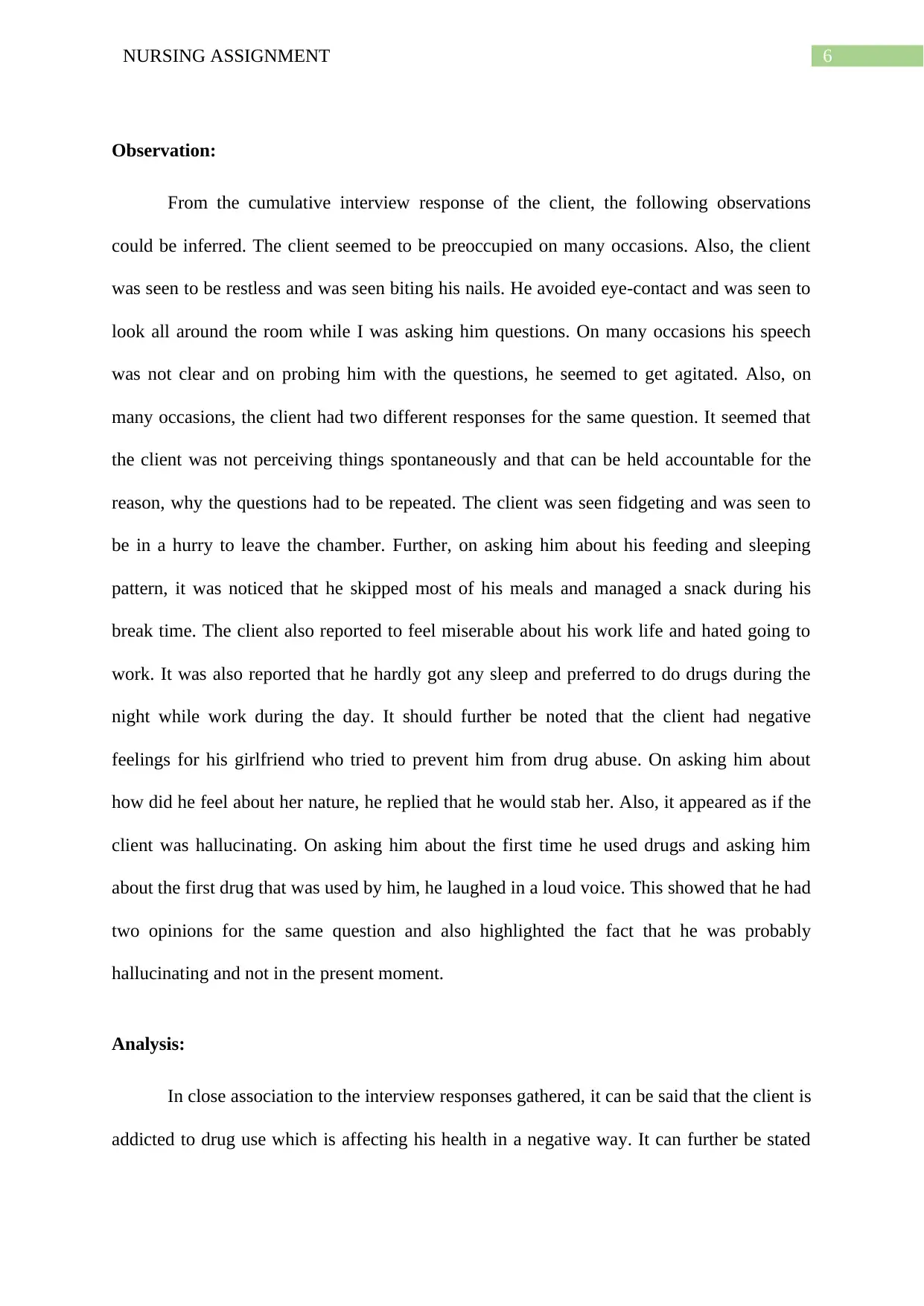
6NURSING ASSIGNMENT
Observation:
From the cumulative interview response of the client, the following observations
could be inferred. The client seemed to be preoccupied on many occasions. Also, the client
was seen to be restless and was seen biting his nails. He avoided eye-contact and was seen to
look all around the room while I was asking him questions. On many occasions his speech
was not clear and on probing him with the questions, he seemed to get agitated. Also, on
many occasions, the client had two different responses for the same question. It seemed that
the client was not perceiving things spontaneously and that can be held accountable for the
reason, why the questions had to be repeated. The client was seen fidgeting and was seen to
be in a hurry to leave the chamber. Further, on asking him about his feeding and sleeping
pattern, it was noticed that he skipped most of his meals and managed a snack during his
break time. The client also reported to feel miserable about his work life and hated going to
work. It was also reported that he hardly got any sleep and preferred to do drugs during the
night while work during the day. It should further be noted that the client had negative
feelings for his girlfriend who tried to prevent him from drug abuse. On asking him about
how did he feel about her nature, he replied that he would stab her. Also, it appeared as if the
client was hallucinating. On asking him about the first time he used drugs and asking him
about the first drug that was used by him, he laughed in a loud voice. This showed that he had
two opinions for the same question and also highlighted the fact that he was probably
hallucinating and not in the present moment.
Analysis:
In close association to the interview responses gathered, it can be said that the client is
addicted to drug use which is affecting his health in a negative way. It can further be stated
Observation:
From the cumulative interview response of the client, the following observations
could be inferred. The client seemed to be preoccupied on many occasions. Also, the client
was seen to be restless and was seen biting his nails. He avoided eye-contact and was seen to
look all around the room while I was asking him questions. On many occasions his speech
was not clear and on probing him with the questions, he seemed to get agitated. Also, on
many occasions, the client had two different responses for the same question. It seemed that
the client was not perceiving things spontaneously and that can be held accountable for the
reason, why the questions had to be repeated. The client was seen fidgeting and was seen to
be in a hurry to leave the chamber. Further, on asking him about his feeding and sleeping
pattern, it was noticed that he skipped most of his meals and managed a snack during his
break time. The client also reported to feel miserable about his work life and hated going to
work. It was also reported that he hardly got any sleep and preferred to do drugs during the
night while work during the day. It should further be noted that the client had negative
feelings for his girlfriend who tried to prevent him from drug abuse. On asking him about
how did he feel about her nature, he replied that he would stab her. Also, it appeared as if the
client was hallucinating. On asking him about the first time he used drugs and asking him
about the first drug that was used by him, he laughed in a loud voice. This showed that he had
two opinions for the same question and also highlighted the fact that he was probably
hallucinating and not in the present moment.
Analysis:
In close association to the interview responses gathered, it can be said that the client is
addicted to drug use which is affecting his health in a negative way. It can further be stated
Paraphrase This Document
Need a fresh take? Get an instant paraphrase of this document with our AI Paraphraser
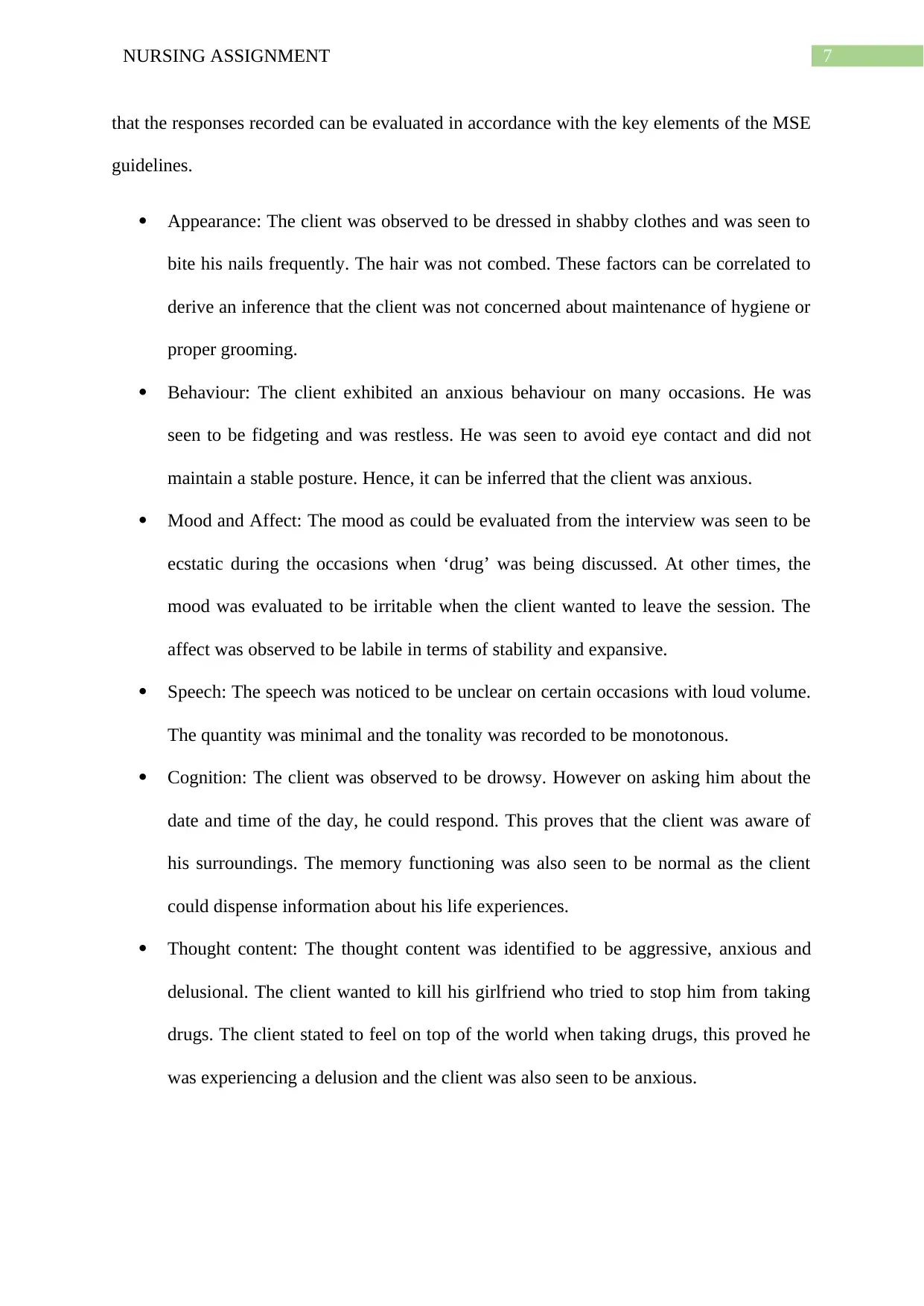
7NURSING ASSIGNMENT
that the responses recorded can be evaluated in accordance with the key elements of the MSE
guidelines.
Appearance: The client was observed to be dressed in shabby clothes and was seen to
bite his nails frequently. The hair was not combed. These factors can be correlated to
derive an inference that the client was not concerned about maintenance of hygiene or
proper grooming.
Behaviour: The client exhibited an anxious behaviour on many occasions. He was
seen to be fidgeting and was restless. He was seen to avoid eye contact and did not
maintain a stable posture. Hence, it can be inferred that the client was anxious.
Mood and Affect: The mood as could be evaluated from the interview was seen to be
ecstatic during the occasions when ‘drug’ was being discussed. At other times, the
mood was evaluated to be irritable when the client wanted to leave the session. The
affect was observed to be labile in terms of stability and expansive.
Speech: The speech was noticed to be unclear on certain occasions with loud volume.
The quantity was minimal and the tonality was recorded to be monotonous.
Cognition: The client was observed to be drowsy. However on asking him about the
date and time of the day, he could respond. This proves that the client was aware of
his surroundings. The memory functioning was also seen to be normal as the client
could dispense information about his life experiences.
Thought content: The thought content was identified to be aggressive, anxious and
delusional. The client wanted to kill his girlfriend who tried to stop him from taking
drugs. The client stated to feel on top of the world when taking drugs, this proved he
was experiencing a delusion and the client was also seen to be anxious.
that the responses recorded can be evaluated in accordance with the key elements of the MSE
guidelines.
Appearance: The client was observed to be dressed in shabby clothes and was seen to
bite his nails frequently. The hair was not combed. These factors can be correlated to
derive an inference that the client was not concerned about maintenance of hygiene or
proper grooming.
Behaviour: The client exhibited an anxious behaviour on many occasions. He was
seen to be fidgeting and was restless. He was seen to avoid eye contact and did not
maintain a stable posture. Hence, it can be inferred that the client was anxious.
Mood and Affect: The mood as could be evaluated from the interview was seen to be
ecstatic during the occasions when ‘drug’ was being discussed. At other times, the
mood was evaluated to be irritable when the client wanted to leave the session. The
affect was observed to be labile in terms of stability and expansive.
Speech: The speech was noticed to be unclear on certain occasions with loud volume.
The quantity was minimal and the tonality was recorded to be monotonous.
Cognition: The client was observed to be drowsy. However on asking him about the
date and time of the day, he could respond. This proves that the client was aware of
his surroundings. The memory functioning was also seen to be normal as the client
could dispense information about his life experiences.
Thought content: The thought content was identified to be aggressive, anxious and
delusional. The client wanted to kill his girlfriend who tried to stop him from taking
drugs. The client stated to feel on top of the world when taking drugs, this proved he
was experiencing a delusion and the client was also seen to be anxious.

8NURSING ASSIGNMENT
Perception: The client can be reported to feel hallucinated. He believed that drugs
could help him deal with any complications and he could rule the world if he was
high.
Insight and Judgement: The client has been experiencing hallucinating symptoms and
it can be predicted that the client can develop a severe personality disorder problem.
The client does not seem to perceive the difference between the right and wrong
actions, primarily because he stringently believes that the solution to every mess
could be sought on using drugs.
Recommendation:
The recommendations that could be prescribed to the patient for a recover would
include the following:
The client should be sent for immediate medical assisted drug detoxification (Volkow
et al., 2013)
The medication routine should be coupled with a counselling therapy. It has been
mentioned that one to one counselling and administration of mild cognitive
behavioural therapy can effectively help in dealing with addiction (Sobell et al., 2013)
An effective treatment intervention must be designed for the patient which would
critically take into consideration the cumulative medical needs of the client and would
not just focus upon the drug addiction (Moos, 2017)
Drug addiction has been defined as a complicated disease that affects the functioning
of the brain and the behaviour of a person (MSI, 2013). In order to devise an effective
care, it must be ensured that the client is registered in a prolong intervention program.
Care should be undertaken so as to make sure that the client does not withdraw from
the intervention regime as it could lead to the relapse of the symptoms (MSI, 2013)
Perception: The client can be reported to feel hallucinated. He believed that drugs
could help him deal with any complications and he could rule the world if he was
high.
Insight and Judgement: The client has been experiencing hallucinating symptoms and
it can be predicted that the client can develop a severe personality disorder problem.
The client does not seem to perceive the difference between the right and wrong
actions, primarily because he stringently believes that the solution to every mess
could be sought on using drugs.
Recommendation:
The recommendations that could be prescribed to the patient for a recover would
include the following:
The client should be sent for immediate medical assisted drug detoxification (Volkow
et al., 2013)
The medication routine should be coupled with a counselling therapy. It has been
mentioned that one to one counselling and administration of mild cognitive
behavioural therapy can effectively help in dealing with addiction (Sobell et al., 2013)
An effective treatment intervention must be designed for the patient which would
critically take into consideration the cumulative medical needs of the client and would
not just focus upon the drug addiction (Moos, 2017)
Drug addiction has been defined as a complicated disease that affects the functioning
of the brain and the behaviour of a person (MSI, 2013). In order to devise an effective
care, it must be ensured that the client is registered in a prolong intervention program.
Care should be undertaken so as to make sure that the client does not withdraw from
the intervention regime as it could lead to the relapse of the symptoms (MSI, 2013)
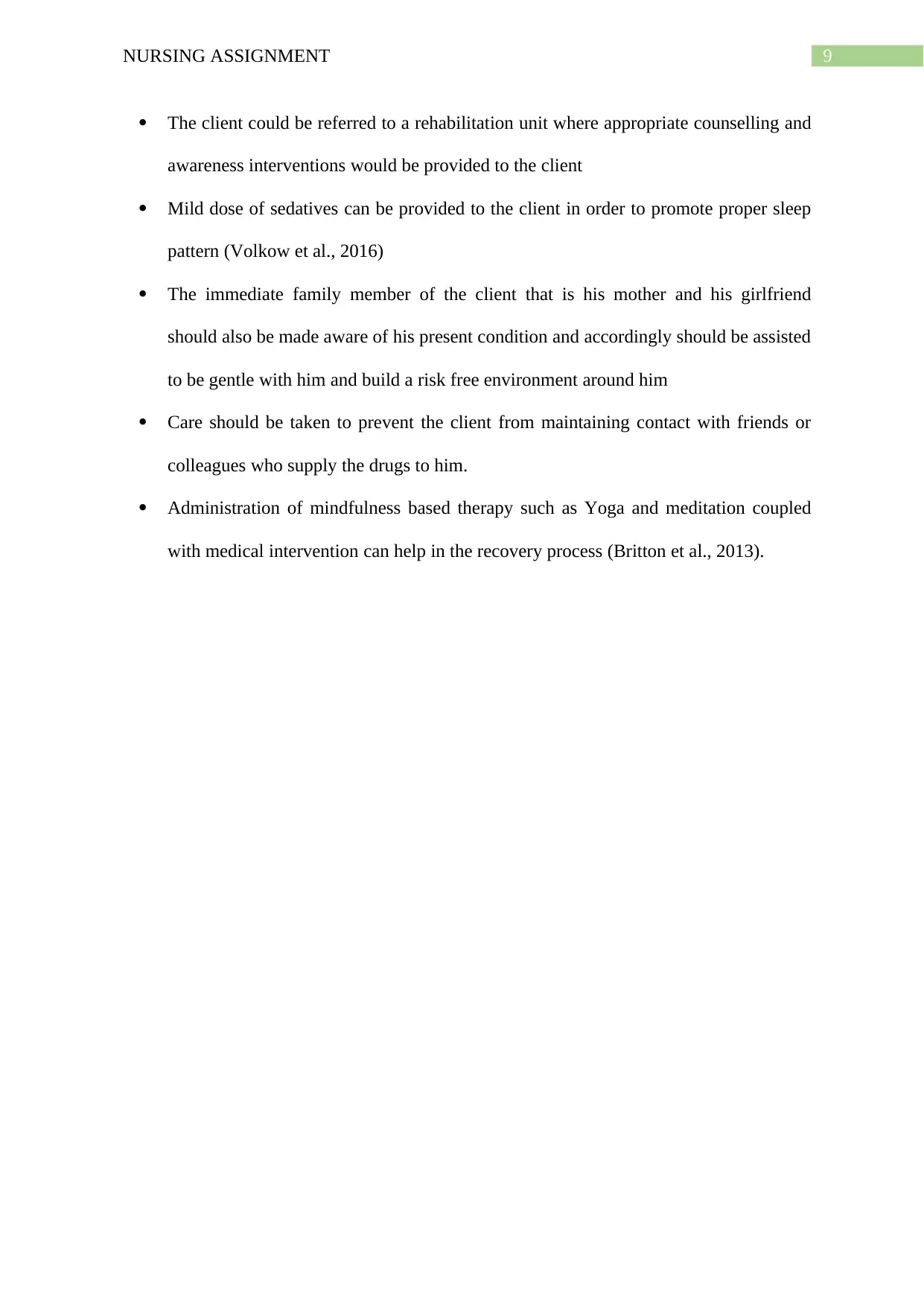
9NURSING ASSIGNMENT
The client could be referred to a rehabilitation unit where appropriate counselling and
awareness interventions would be provided to the client
Mild dose of sedatives can be provided to the client in order to promote proper sleep
pattern (Volkow et al., 2016)
The immediate family member of the client that is his mother and his girlfriend
should also be made aware of his present condition and accordingly should be assisted
to be gentle with him and build a risk free environment around him
Care should be taken to prevent the client from maintaining contact with friends or
colleagues who supply the drugs to him.
Administration of mindfulness based therapy such as Yoga and meditation coupled
with medical intervention can help in the recovery process (Britton et al., 2013).
The client could be referred to a rehabilitation unit where appropriate counselling and
awareness interventions would be provided to the client
Mild dose of sedatives can be provided to the client in order to promote proper sleep
pattern (Volkow et al., 2016)
The immediate family member of the client that is his mother and his girlfriend
should also be made aware of his present condition and accordingly should be assisted
to be gentle with him and build a risk free environment around him
Care should be taken to prevent the client from maintaining contact with friends or
colleagues who supply the drugs to him.
Administration of mindfulness based therapy such as Yoga and meditation coupled
with medical intervention can help in the recovery process (Britton et al., 2013).
Secure Best Marks with AI Grader
Need help grading? Try our AI Grader for instant feedback on your assignments.

10NURSING ASSIGNMENT
References:
Britton, W. B., Bootzin, R. R., Cousins, J. C., & Hasler, B. P. (2013). The contribution of
mindfulness practice to a multicomponent behavioral sleep intervention following substance
abuse treatment in adolescents: a treatment development study. In Mindfulness-Related
Treatments and Addiction Recovery (pp. 92-103). Routledge.
Moos, R. H. (2017). Evaluating treatment environments: The quality of psychiatric and
substance abuse programs. Routledge.pp.67
MSI, M. S. I. (2013). Substance Abuse and Mental Health Services Administration.pp.57-68
Sobell, L. C., Sobell, M. B., & Ward, E. (Eds.). (2013). Evaluating alcohol and drug abuse
treatment effectiveness: Recent advances. Elsevier.pp.27-35
Volkow, N. D., Frieden, T. R., Hyde, P. S., & Cha, S. S. (2014). Medication-assisted
therapies—tackling the opioid-overdose epidemic. New England Journal of
Medicine, 370(22), 2063-2066.
Volkow, N. D., Koob, G. F., & McLellan, A. T. (2016). Neurobiologic advances from the
brain disease model of addiction. New England Journal of Medicine, 374(4), 363-371.
References:
Britton, W. B., Bootzin, R. R., Cousins, J. C., & Hasler, B. P. (2013). The contribution of
mindfulness practice to a multicomponent behavioral sleep intervention following substance
abuse treatment in adolescents: a treatment development study. In Mindfulness-Related
Treatments and Addiction Recovery (pp. 92-103). Routledge.
Moos, R. H. (2017). Evaluating treatment environments: The quality of psychiatric and
substance abuse programs. Routledge.pp.67
MSI, M. S. I. (2013). Substance Abuse and Mental Health Services Administration.pp.57-68
Sobell, L. C., Sobell, M. B., & Ward, E. (Eds.). (2013). Evaluating alcohol and drug abuse
treatment effectiveness: Recent advances. Elsevier.pp.27-35
Volkow, N. D., Frieden, T. R., Hyde, P. S., & Cha, S. S. (2014). Medication-assisted
therapies—tackling the opioid-overdose epidemic. New England Journal of
Medicine, 370(22), 2063-2066.
Volkow, N. D., Koob, G. F., & McLellan, A. T. (2016). Neurobiologic advances from the
brain disease model of addiction. New England Journal of Medicine, 374(4), 363-371.
1 out of 11
Your All-in-One AI-Powered Toolkit for Academic Success.
+13062052269
info@desklib.com
Available 24*7 on WhatsApp / Email
![[object Object]](/_next/static/media/star-bottom.7253800d.svg)
Unlock your academic potential
© 2024 | Zucol Services PVT LTD | All rights reserved.





